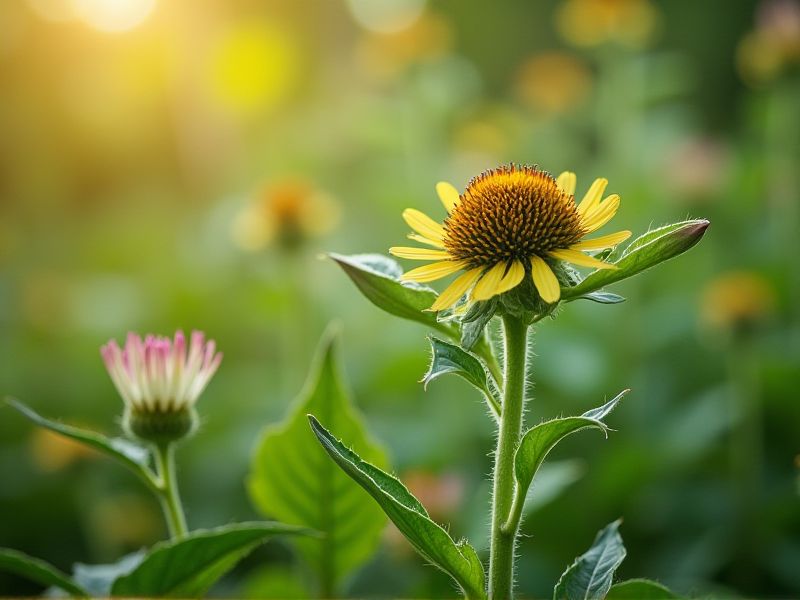
Medicinal plants that thrive outdoors include Echinacea, known for boosting the immune system, and Lavender, celebrated for its calming properties. Peppermint is another resilient choice, offering digestive benefits and a refreshing aroma that enhances gardens. Calendula, with its bright orange flowers, provides anti-inflammatory effects and is often used in skin treatments. You can also grow Sage, recognized for its antimicrobial qualities and ability to improve cognitive function. These outdoor plants not only enhance your garden's aesthetic but also serve as valuable natural remedies for various ailments.
List of some Medicinal plants that thrive outdoors
- Aloe Vera (Aloe barbadensis miller)
- Peppermint (Mentha piperita)
- Lavender (Lavandula angustifolia)
- Chamomile (Matricaria chamomilla)
- Echinacea (Echinacea purpurea)
- Lemon Balm (Melissa officinalis)
- Yarrow (Achillea millefolium)
- Rosemary (Rosmarinus officinalis)
- St. John's Wort (Hypericum perforatum)
- Calendula (Calendula officinalis)
Important things about Medicinal plants that thrive outdoors
Sunlight Tolerance
Medicinal plants such as Echinacea, Lavender, and Peppermint exhibit a high level of sunlight tolerance, making them ideal for outdoor cultivation. These plants not only benefit from direct sunlight, which enhances their growth and potency, but also contribute to ecosystem biodiversity by attracting pollinators. Echinacea is known for its immune-boosting properties, while Lavender offers both therapeutic benefits and aromatic qualities. By planting these sun-loving species in your garden, you can create a vibrant and healing outdoor space that thrives under the sun.
Soil Preferences
Medicinal plants that thrive outdoors, such as echinacea, lavender, and peppermint, prefer well-draining soil with a pH range between 6.0 and 7.5. Rich, loamy soil mixed with organic compost enhances nutrient availability, promoting robust growth and higher medicinal potency. These plants typically require full sun exposure for several hours daily, along with moderate moisture to prevent root rot while encouraging healthy development. To cultivate these plants successfully, ensure proper soil composition that aligns with their natural habitat preferences, thereby maximizing your herbal harvest.
Watering Requirements
Medicinal plants that thrive outdoors, such as Echinacea, Lavender, and Peppermint, generally require well-drained soil and consistent moisture for optimal growth. Regular watering is essential, especially during dry spells, with deep watering recommended once a week to encourage strong root development. It's important to avoid overwatering, as this can lead to root rot; ensuring that the soil remains damp but not soggy is key. Consider applying mulch around your plants to help retain soil moisture and regulate temperature, creating a conducive environment for these beneficial herbs.
Growth Habits
Medicinal plants such as echinacea, lavender, and peppermint flourish in outdoor environments, benefiting from ample sunlight and well-drained soil. Echinacea, known for its immune-boosting properties, grows best with six hours of direct sunlight daily, preferring sandy or loamy soils. Lavender, revered for its calming effects, not only thrives in full sun but also resists drought, making it suitable for xeriscaping gardens. Peppermint, with its aromatic leaves and digestive health benefits, enjoys moist, fertile ground and can easily spread in garden beds, offering a robust yield for harvest.
Pest Resistance
Medicinal plants such as Echinacea, Neem, and Calendula exhibit remarkable pest resistance, making them ideal for outdoor cultivation. Echinacea, renowned for its immune-boosting properties, contains compounds that deter harmful insects while attracting beneficial pollinators. Neem, known for its natural insecticidal properties, offers a sustainable approach to pest management and enhances the plant's resilience without harming the ecosystem. By incorporating pest-resistant medicinal plants into your garden, you can foster a thriving outdoor environment while maximizing the health benefits these plants provide.
Seasonal Changes
Medicinal plants such as Echinacea, Lavender, and Peppermint showcase remarkable resilience and adaptability to seasonal changes, thriving outdoors in various climates. During spring, these plants awaken and begin to bloom, providing essential oils that contribute to their healing properties. In summer, their leaves and flowers expand, maximizing photosynthesis, which enhances their medicinal characteristics and overall potency. As autumn approaches, the harvesting of these plants becomes crucial, ensuring that you collect them at their peak for optimal medicinal use and storage.
Harvesting Techniques
Harvesting medicinal plants outdoors requires knowledge of optimal times and methods to ensure the plants' potency and sustainability. Early morning is generally the best time to collect leaves, flowers, and roots, as moisture levels are lower and essential oils are at their peak. It's crucial to use clean, sharp tools to minimize damage to the plant and ensure a clean cut, which helps maintain its health. To promote sustainability, always leave some plants and seeds behind, allowing them to regenerate for future harvesting while preserving the ecosystem.
Companion Planting Benefits
Companion planting enhances the growth and medicinal properties of various plants, making your outdoor garden more effective and diverse. For instance, planting basil alongside tomatoes not only improves tomato flavor but also repels pests, promoting healthier plants that can be used in your herbal remedies. Calendula, known for its anti-inflammatory properties, thrives near plants like cabbage, which can attract beneficial insects that pollinate and fortify your medicinal garden. Choosing the right combinations ensures that your outdoor space not only flourishes but also provides a rich source of natural remedies.
Medicinal Properties
Medicinal plants that thrive outdoors, such as Echinacea purpurea and Calendula officinalis, offer a range of therapeutic benefits. Echinacea, commonly known as purple coneflower, is renowned for its immune-boosting properties, often used to combat colds and infections. Meanwhile, Calendula is celebrated for its anti-inflammatory and antiseptic qualities, making it effective in wound healing and skin conditions. Cultivating these plants in your garden not only enhances your outdoor space but also provides natural remedies for everyday ailments.
Local Climate Adaptability
Medicinal plants that thrive outdoors exhibit remarkable adaptability to various local climates, showcasing resilience and biodiversity. For instance, Echinacea purpurea, commonly known as coneflower, flourishes in temperate regions and is valued for its immune-boosting properties. In hotter climates, plants like Aloe vera thrive, offering soothing gel beneficial for skin ailments. By incorporating these hardy species into your garden, you not only enhance local ecosystems but also gain access to natural remedies tailored to your climate.
